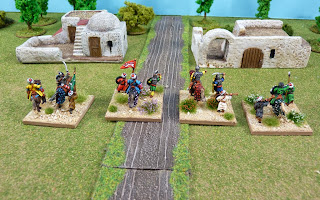Being thrifty, I'm slow to upgrade my hobby tools. When I do open my wallet to make an upgrade, I rely on the reviews and recommendations of my fellow bloggers to help me find the good stuff. To that noble cause, I've compiled a list of my favorite tools and upgrades in 2013. The envelope please!
Daylight Triple Bright Lamp: This was my top upgrade of the year. The Triple Bright lamp puts out 250W of high-powered wide-area lighting. For painters over 40, you'd be surprised by how quality lighting can improve your painting! The lamp is very adjustable and I angle mine so my minis are top and front lit. The first time I used it for miniature photography, the quality of my pictures improved. Literally, this lamp is brilliant!
Pro Arte Series 107 Spotter Brush 2/0 and 3/0: The Pro Arte series is made for miniature painters and it shows. The point is very short and the effect is like using a micron pen for applying small, precise detail. I can't find a US distributor at the small sizes but I did find a UK eBay store that ships to the US. I use these for 15mm and 28mm detail work. Since they're not Sable brushes, the tip does curl under heavy use.
Raphael 8404 Kolinsky Sable Brush 0: In my collection of Kolinsky Sables, the Raphael beats all others by keeping a perfect tip month after month. It's my go-to brush.
Dremel drill + the 225-01 Flex Shaft: I've been using a pin drill for years. Drilling out hundreds of 15mm Xyston hands is grueling and painful work. This combo lets me drill out a hand in seconds and the flex shaft gives me a smaller, lighter and more precise tool. I can't believe I took so long to come around to this solution. It's so good, I could use it for dental work. The Dr. of Brushes will see you now!
Tamjima Grass Tufts: I used to be a Silflor tuft guy but I like Tamjima's better. No gluing required. Peel a clump from the backing paper with tweezers and place it directly
onto the base. I keep a variety of heights and colors on hand for all of my basing needs.
Paint Stand: This is actually a nail polish stand but for $22, who cares? It goes together in minutes and holds 78 Vallejo paints comfortably. Foundry paint pots fit comfortably as well. I have one up and I'm going to get a 2nd for Christmas. The obsessive compulsive part of me highly approves of this upgrade!
Vallejo Paints: My paint collection needed a refresh and I was looking to make a big paint buy in something other than Vallejos I use. I like Vallejo but with so many choices, I wanted to shake things up by buying a set in a different line. I did try other paints this year but each came up lacking. After much thought, the hunt ended with me back where I started. I picked 70 new Model Color Vallejo paints from The War Store and set them up in my new paint stand.
Robart Hobby Paint Shaker: At 5000 shakes per minute, even John Henry couldn't beat this machine. Don't forget to buy replacement straps as they do wear out.
Alibris Books: Yes, Amazon is THE online book seller. For out of print, hard to find and expensive military history books, give Alibris a spin. They're an online network of independent booksellers. With such a deep inventory, I've locating hard to find titles and occasionally, they come up cheaper than Amazon.
Core Sec Omni-Ruler: Cor Sec is a US company that makes (among other things) measuring stick in 1" segments. Each segment is threaded and colored so you can quickly custom build to any distance
you like. I mixed and matched colors to build 2", 4", 6" and 12" sticks. Now that I've been using them, I'd never go back to a plastic ruler!
I'm sure there are many great tools I haven't heard of or thought of yet. I'd love to hear about the ones I missed. What were your favorite tools this year?
































